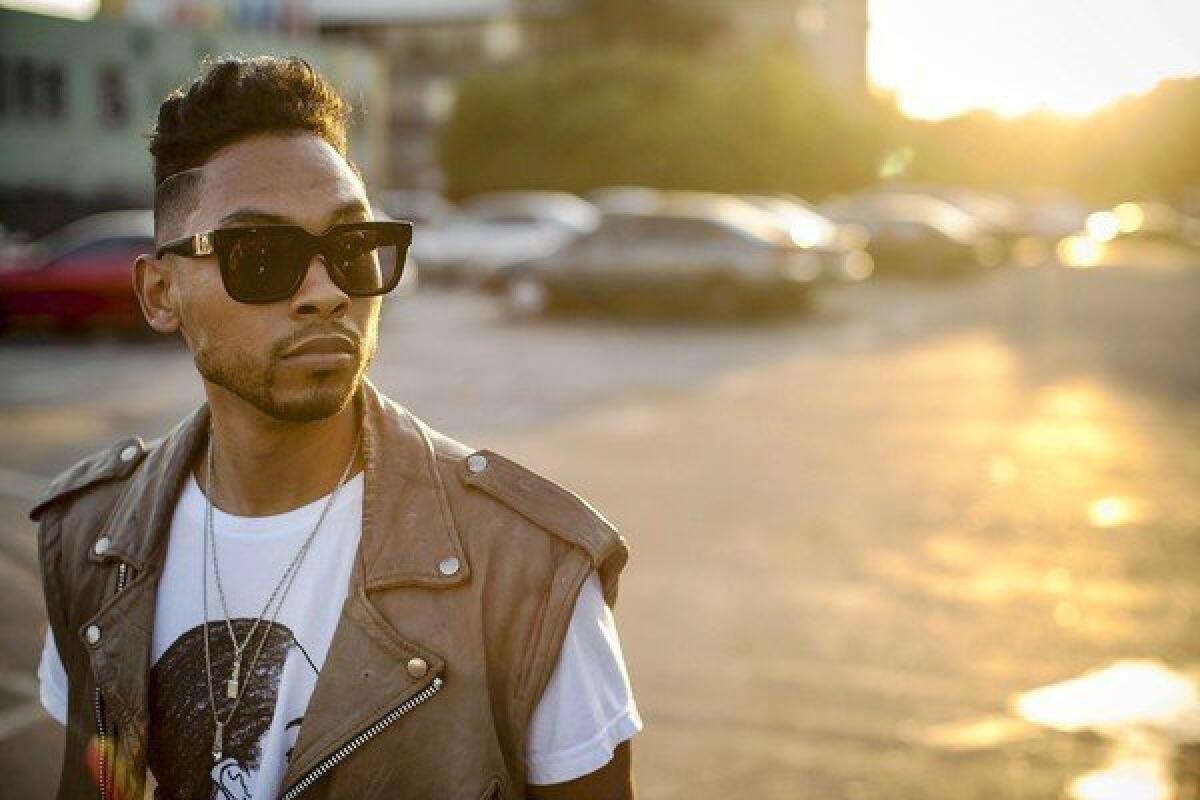Miguel helps lead the charge for an edgier kind of R&B; artist

- Share via
On Billboard’s current R&B; chart, nestled somewhere between Rihanna’s latest inescapable hit and club bangers from Trey Songz, is Miguel’s left-of-center gem, “Adorn.”
Miguel’s self-produced slow burner, with its subdued groove and emotive croons, is so different from urban radio offerings of late that it seemed destined to be swallowed by bigger records from better known acts.
But “Adorn” nabbed a spot on the charts — and has stayed there for nearly seven months.
PHOTOS: Celebrity portraits by the Times
“I remember thinking how crazy would it be if they played this on the radio,” he said of the single that spent four weeks at No. 1. “None of my songs have ever sounded like anything that was going on the radio.”
“Adorn’s” sleeper surprise gave the L.A.-based avant-soul singer, born Miguel Pimentel, his breakout moment and set the tone for his recently released sophomore disc, “Kaleidoscope Dream.” But it also signaled a much bigger change in the genre it came from.
The 25-year-old leads a wave of artists aggressively pulling away from the conventional boundaries of R&B; by championing edgier, genre-blending productions while maintaining soulful melodies.
Neglecting the beats that have propelled the genre to the top of the charts over the past decade (be it the bass-heavy hip-hop of a few years ago or the four-on-the-floor Europop of today), Miguel and acts such as Frank Ocean, the Weeknd, Mateo and Dawn Richard are cutting their own versions of alternative R&B.;
The new movement feels like the most significant stylistic change in R&B; since neo-soul rolled around in the 1990s. It was driven by singer-songwriters such as Erykah Badu, Maxwell, D’Angelo, Lauryn Hill and Jill Scott, who were seen as soul revivalists with debuts that infused jazz, funk and African elements into R&B.;
When Miguel arrived in 2010, he offered a hybrid of R&B;, funk, hip-hop, dubstep, rock and electronica — which he branded “eclec-tric” — and although his debut disc, “All I Want Is You” spawned minor hits like the sublime “Sure Thing,” his modern take on classic soul was overlooked as an acquired taste.
PHOTOS: Celebrity portraits by the Times
As off-kilter as his debut was, it proved merely a teaser for the unconventional rhythms he offered in “Kaleidoscope Dream,” a disc that brimmed with buzzing synthesizers, heavy melodies and psychedelic grooves. After building a following with fierce live performances, the disc opened to critical acclaim and debuted at No. 3 on the Billboard 200.
“I hope more artists who are R&B; at the core and pushing the boundaries will join me in embracing the fact that [the genre] did become a stereotype,” said Miguel. “I’m proud to wave the flag for what’s coming.”
“Kaleidoscope Dream” quickly garnered comparisons to another fully realized disc, Ocean’s breakthrough “Channel Orange.” Released earlier this year, Ocean’s Def Jam debut was celebrated for its eccentricities, confessional storytelling and disregard for the trends scoring radio play.
“Frank Ocean’s album was an example — he wasn’t making music for radio,” said Fuzzy Fantabulous, producer for Big Boy’s KPWR (105.9 FM) morning show and director of talent relations for Stampede Management. “It seems like everybody was trying to do the four-to-the-floor, Pitbull-type music, and I get it, they want to go overseas and tour.”
Recent club-savvy releases from crooners such as Usher, Chris Brown and Ne-Yo have reflected that shift toward EDM. Rihanna, who has long teetered between urban and dance-pop, ruled radio last year with “We Found Love,” produced by popular dance DJ Calvin Harris.
Both Brown and Usher were criticized for alienating core R&B; fans with more pop and dance-leaning tracks. Their albums debuted at No. 1, but sold half of what their predecessors did on the first week.
Usher said the current influx of global, electronic dance music in pop influenced his latest record, “Looking 4 Myself.” He explored new textures and it worked, especially on lead single “Climax. It spent 11 weeks at No. 1 on the R&B;/hip-hop chart. He followed up with an aggressive synth-pop dance track.
“I went to Coachella. I went to Ibiza, Korea, Asia and South America. I heard all these different types of music,” Usher said ahead of his album release. “As I went city to city, country to country, I would turn on the radio, see what the DJ was doing and of course paid attention to what was happening in terms of sales. Electronic music had become more relevant, and DJs had become more significant in breaking sounds.
“I wanted to get in there, that wasn’t a space where a lot of artists were,” he continued. “I realized this stream is moving upward. The one thing people criticized is there was a certain sound that had a certain essence that was kind of departed from soul and R&B; and that’s what I’m synonymous with and I went to a very dance sound. But that’s where music was going. It was a slow start for me but a quick start for the rest of the world.”
Up and coming alt-R&B; singer-songwriter Mateo believes the phenomenon of the pop/dance/R&B; hybrid has reached its peak. “In order for urban singers to chart on those platforms, you gotta come out with a four-to-the-floor joint,” the L.A.-based Cincinnati native said. “What I see now is an appreciation starting to build for the R&B; that used to be. There is a renaissance happening.”
Mateo built an online following with a series of mixtapes, EPs and videos. He’s racked up more than a million views on YouTube and landed a deal with Interscope. “Its definitely R&B;, it has soul in it,” he said of his sound. “But there’s elements of alternative rock, there’s the big drums. I always felt like urban music didn’t have the euphoric sound that you shout at stadiums.”
Online discovery has played a critical role in breaking these acts, with each of them taking control of their music and bypassing traditional methods.
When Ocean grew frustrated with Def Jam he released a mixtape, “Nostalgia, Ultra,” for free on Tumblr. He was already a critic’s darling, a member of L.A.’s hip-hop collective Odd Future and selling out shows before “Channel Orange” hit stores earlier this year, a rarity for R&B; acts that have been dependent on radio and music videos.
Miguel rolled out “Kaleidoscope Dream” in three parts to promote the album. Fans who purchased either preview (dubbed “Air” and “Water”) could use iTunes’ Complete My Album program for the full record. He followed a similar method when he introduced fans to new music with “Art Dealer Chic,” a series of conceptual micro EPs that he released free for three consecutive months, earlier this year. “Any kind of anticipation or newfound acceptance really comes from that,” he said.
The DIY model worked for the Weeknd, who released a trilogy of free albums last year and has since teamed with a major label to reissue the set. It’s also the foundation for Richard’s solo career. She is launching a solo career after finding success in two different groups: urban pop girl group Danity Kane and hip-hop fusion collective Diddy Dirty Money.
Armed with a tiny team (her producer also manages her) she released an EP, “Armor On,” earlier this year exclusively on iTunes. It sold more than 30,000 copies without any radio play and hit No. 1 on the iTunes R&B; albums chart and No. 4 on Billboard’s Heatseekers chart.
“There [is] a transition happening,” said Richard, whose debut, “Goldenheart,” is due in the new year and will be distributed by indie company Altavoz Distribution. “R&B; doesn’t have to be so linear. [‘Armor On’s’ success] was a confirmation that a new kind of artist can succeed.”
Devin Lazerine, founder and editor of the R&B;/hip-hop news site Rap-Up, said listeners are no longer letting radio dictate their playlists.
“There is a demand for more ‘real’ R&B; that is showcasing vocals and less studio effects,” he said. “It’s almost a response to the inundation of pop.”
Fuzzy puts it more bluntly: “I’m sure radio probably frustrates a lot of artists because they hear what is going on radio. And when [certain artists] do it they get chastised for it,” he said. “It’s almost our fault — and their fault for compromising.”
PHOTOS AND MORE:
PHOTOS: Iconic rock guitars and their owners
The Envelope: Awards Insider
PHOTOS: Unfortunately timed pop meltdowns
More to Read
The biggest entertainment stories
Get our big stories about Hollywood, film, television, music, arts, culture and more right in your inbox as soon as they publish.
You may occasionally receive promotional content from the Los Angeles Times.










